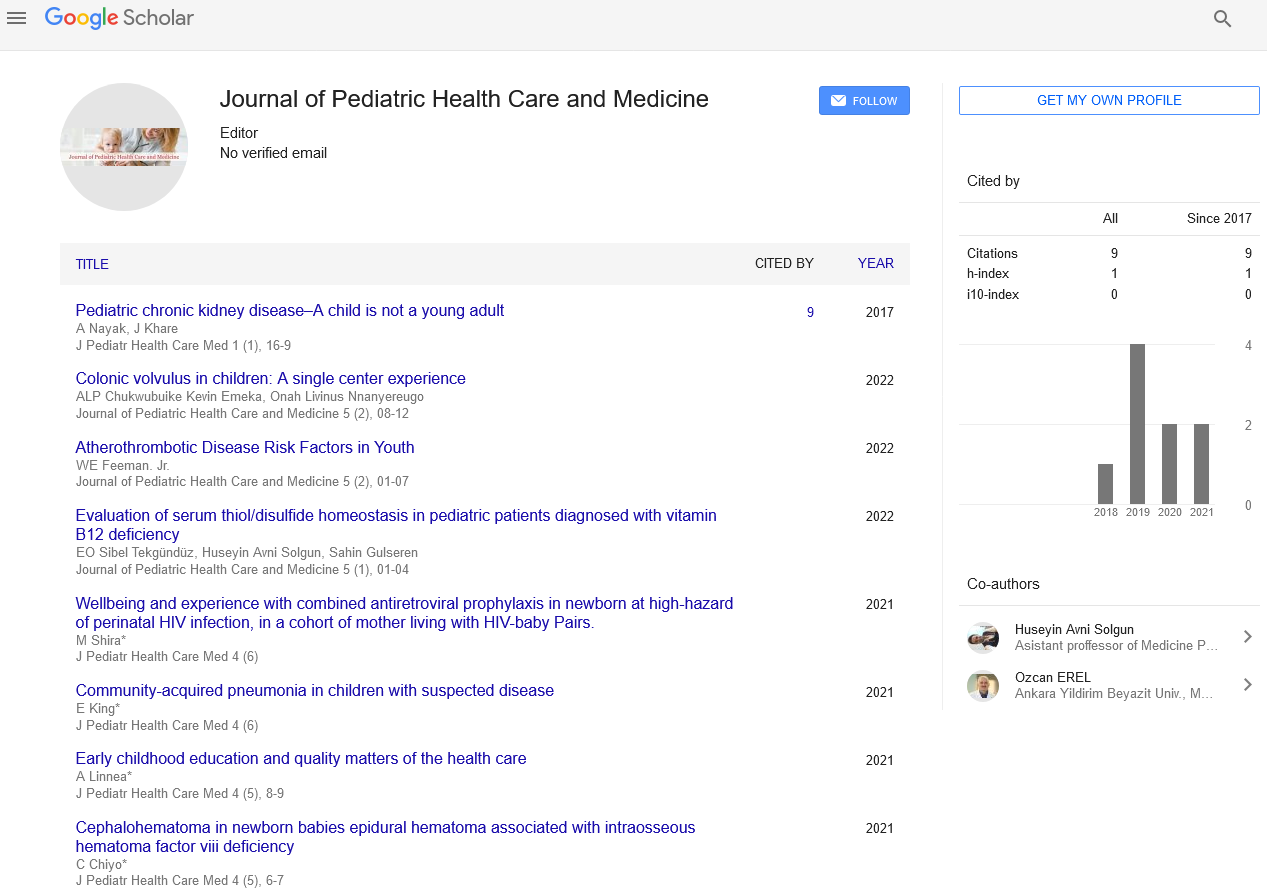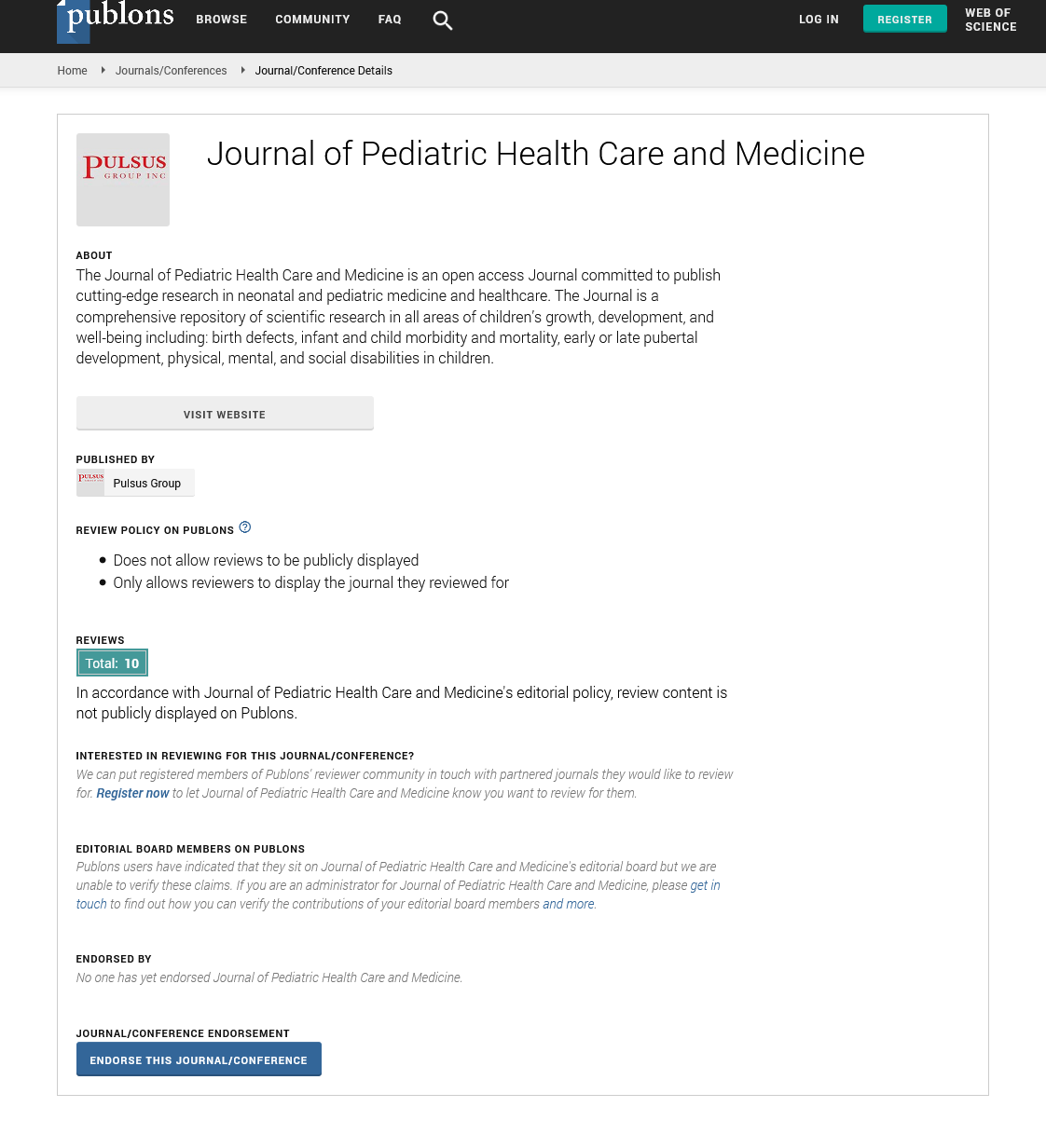Multidisciplinary approach of tourette syndrome in pathophysiology, complexities and treatment
Received: 02-Sep-2021 Accepted Date: Sep 16, 2021; Published: 23-Sep-2021
Citation: Shira Z. Multidisciplinary approach of tourette syndrome in pathophysiology, complexities and treatment. . J Pediatr Health Care Med. 2021;4(5):12-13.
This open-access article is distributed under the terms of the Creative Commons Attribution Non-Commercial License (CC BY-NC) (http://creativecommons.org/licenses/by-nc/4.0/), which permits reuse, distribution and reproduction of the article, provided that the original work is properly cited and the reuse is restricted to noncommercial purposes. For commercial reuse, contact reprints@pulsus.com
Abstract
Tourette condition is a typical innate neuropsychiatric issue comprising of various spasms and vocal commotions. We sum up here clinical parts of 250 back to back cases seen over a time of 3 years. The sex proportion was four guys to one female, and the mean period of beginning was 6.9 years. Just 10% were Jewish, showing that it isn’t more common in Ashkenazi Jews. Just 33% had enthusiastic swearing (coprolalia), showing that this isn’t required for the conclusion. The most successive introductory side effects were quick eye-flickering, facial scowling, and throat-clearing. In this series, obviously Tourette condition is a mental just as a neurological problem. Critical discipline issues as well as issues with outrage and viciousness happened in 61%, and 54% had a lack of ability to concentrate consistently jumble with hyperactivity. Some level of exhibitionism was available in 15.9% of guys and 6.1% of females. Fanatical habitual conduct was seen in 32%. Other than spasms and vocal clamors, the most well-known parental grumblings were of touchiness and everything being a showdown. There were no critical clinical contrasts among familial and irregular cases. At whatever point a youngster gives a learning issue, a lack of ability to concentrate consistently jumble, or critical discipline or enthusiastic issues, the guardians ought to be examined regarding the presence of spasms or vocal commotions in the patient and other relatives.
Introduction
The Trademark indications of the problem are unexpected tedious engine and phonic spasms. Clinically, this is a mind boggling jumble wherein the seriousness, recurrence, variance, and restriction of discourse and spasms are exceptionally individual In clinical practice, the trademark provisions of spasms going with TS were found. Spasms are believed to be unexpected, however they can be stifled briefly by will. In any case, there is a “bounce back” marvel, when after concealment the collected spasms break out at a more noteworthy power than is common for the patient. The decay of spasms (both in quality and amount) can happen under pressure, energy, or weariness. In actuality, spasm articulations retreat when the patient is occupied with a psychological or active work requiring focus. Frequently there is an internal pressure before the spasms breaks out, and after execution of the spasms, the patient feels alleviated. Strangely, spasms can endure in all phases of rest. Furthermore, the issue is regularly joined by mental conduct issues, for example, consideration shortfall hyperactivity issue (ADHD), over the top enthusiastic problem (OCD), self-damaging conduct, gloom, or explicit learning inabilities [1].
Epidemiology
The manifestations of TS start effectively in youth and the assessed pervasiveness is 3–9/1,000 kids more youthful than the young. The normal age at which the main scene of engine spasms happens is 4–6 years. TS is more normal in young men than in young ladies with a pervasiveness of 3–4:1. The phonic spasms transcendently follow the engine ones. Practically speaking, crude simplex sounds like sniffing and hacking are frequently erroneously credited to “sensitivities” from the start. Writing states that the greatest in the seriousness of TS appearances happens at 10 years old 12 years. Most patients will have total or almost complete reduction of the problem after 21 years old enough. In 10–20% of cases, TS manifestations change, continue, or even deteriorate (3–5). Event of spasms is regularly gone before by social issues most normally ADHD—at the time of 3 years. Then again, the main side effects of OCD show up as long as quite a while after the start of spasms with the maximal seriousness in late puberty. Both of these mental comorbidities frequently continue until adulthood, in any event, during TS abatement [2].
Etiology and pathophysiology
The reason for TS isn’t yet known. It is accepted that the improvement of the problem is molded by the investment of the hereditary and nongenetic (epidemiological) factors. TS has a place with polygenic innate issues, where a few distinct qualities are associated with the problem. Despite the fact that chromosomal distortions infrequently happened in patients with TS, a reasonable hereditary reason has not yet been uncovered. The adverse consequences of the climate are essentially pre-birth admissions (maternal pressure in pregnancy, smoking, contaminations, fetal hypoxia) and distressing occasions in the kid’s life. Tourette condition pathophysiological components have not yet been clarified. Numerous discoveries are demonstrative of natural beginning. Despite the fact that spasms are unquestionably somewhat impacted by will, neurophysiological investigations show that spasms are not driven by typical engine ways intended to control free developments.
Diagnosis
A significant analytic marker might be the non-limited, minimal explicit and ineffectively portrayed inclination to move, the supposed “portentous urge.” Patients frequently see spasms as overwhelming, however intentionally done. The deliberate part of these developments can be a valuable component for separating spasms from other monotonous practices (myoclonus, useful jerks, stereotypies). Insights and sentiments going before the engine spasms are simply compulsory. This marvel is firmly identified with the chance of psychological conduct mediation of spasms (zeroed in on practicing consideration and adapting to reactions to impulse). Two scaling techniques have been created to evaluate the foreboding inclinations: the Premonitory Urges for Tics Scale and the University of São Paulo Sensory Phenomena Scale
Treatment
At first, TS was viewed as a simply mental sickness, and, hence, just psychotherapeutic techniques, and specifically psychodynamic, were utilized in its therapy. In the mid-1960s of the previous century, haloperidol was brought into the treatment of spasms as a delegate of traditional antipsychotics, and hence started the period of pharmacotherapy of the appearances of the problem. As the information about the idea of the problem was made more explicit, social treatment (BT) and profound cerebrum incitement (DBS) became significant. The primary line treatment ought to be socio-instruction on the amiability of spasms, this training ought to be given to the patient, yet additionally his/her family, instructors, and individual understudies. In the subsequent line, specialists ought to go to reasonable pharmacotherapy that can run simultaneously with neuropsychological mediations, yet can be led without them. The last treatment alternative is neurosurgical treatment, particularly DBS. This alternative ought to be held for patients who don’t react to neurocognitive mediations or pharmacotherapy, or those patients who react to treatment, yet have intense incidental effects [3].
Neuropsychological interventions
The neuropsychological mediations might assist with expanding confidence, alleviates burdensome sentiments because of a problem. The proof based and the most well-known medicines appear to be propensity inversion preparing (HRT), openness and reaction counteraction (ER), and thorough social mediation. In any case, these treatments are unrealistic for psychologically disabled patients. Propensity inversion preparing comprises of five key methods: mindfulness preparing, improvement of a contending reaction, possibility the board, unwinding preparing, and speculation of abilities. Emergency room is a technique for psychological BT and type of openness treatment in which people face their feelings of dread and cease their departure reaction. CBIT is a typical organized treatment, which trains patients to become mindful of their spasms and shows them explicit conduct techniques that lessen spasms. Moreover, patients are encouraged to do psychoeducation, which comprehends the idea of TS [4].
Conclusion
Despite the fact that more than 130 years have passed, since the TS in 1885, there are as yet numerous unanswered inquiries. The specific reason for changes in mind tissue stays obscure. Essentially, profoundly successful, designated, and safe treatment is as yet inaccessible. Concerning TS treatment, there are as yet a few disputable points, their principle denominator is the absence of clinically significant investigations or relative examinations. Thus, it isn’t totally certain whether psychotherapy or pharmacotherapy ought to be the main line of treatment or regardless of whether cannabinoids in TS treatment ought to or ought not to be utilized.
REFERENCES
- Gunduz A, Okun MS. A review and update on tourette syndrome: where is the field headed? Curr Neurol Neurosci Rep. 2016;16:37.
- Robertson MM, Eapen V, Singer HS, et al. Gilles de la Tourette syndrome. Nat Rev Dis Primers. 2017;3:16097.
- Obeso JA, Rothwell JC, Marsden CD. Neurophysiology of Tourette syndrome. Adv Neurol. 1982;35:105–114.
- Jankovic J, Rohaidy H. Motor, behavioral and pharmacologic findings in Tourette’s syndrome. Can J Neurol Sci. 1987;14:541.






